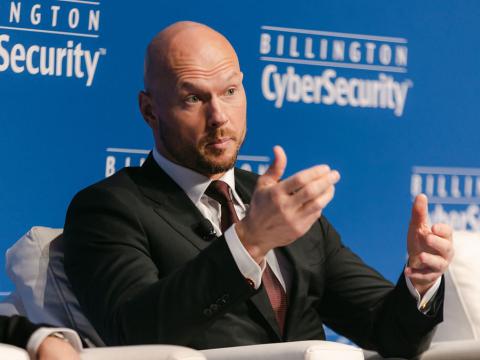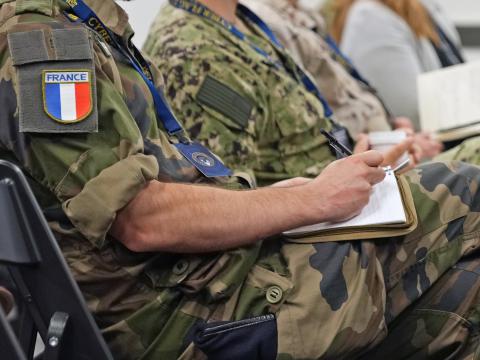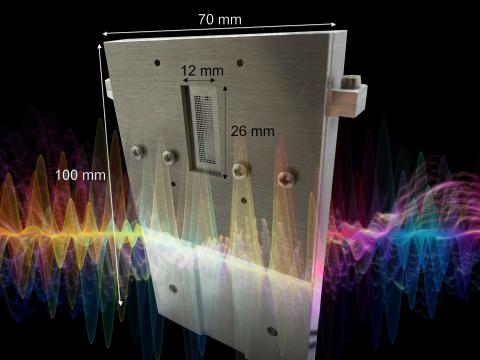Experimental Technology Connects Warriors
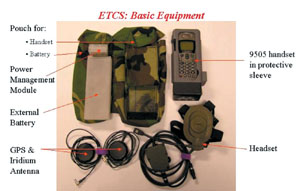
The Expeditionary Tactical Communications System (ETCS) will provide U.S. Marines in Iraq and the Horn of Africa with a secure voice and messaging system. The ETCS uses the Iridium satellite network to connect warfighters with other units up to 200 nautical miles away.
New applications keep Marine units in touch and on the move.
A prototype over-the-horizon communications system and an on-the-move command post that allows commanders to conduct fully mobile operations could help the U.S. Marine Corps maintain connectivity and situational awareness on the battlefield. Developed by the U.S. Marine Corps Warfighting Laboratory in Quantico, Virginia, both systems support the service’s doctrine of ship-to-objective maneuver, which calls for the rapid deployment of troops and equipment from the seat to staging areas deep inside enemy territory.
Even before military operations in Iraq and Afghanistan, Marine Corps planners determined that additional communications and command and control capabilities were required to conduct such operations effectively. The new support applications are the Expeditionary Tactical Communications System (ETCS) and the On the Move Combat Operations Center (OTM COC).
The ETCS is a concept-based experimentation program originally developed to support the laboratory’s Sea Viking 2004 Advanced Warfighting Experiment (SIGNAL, May 2003, page 43). It is designed to provide Marine units with an over-the-horizon communications capability not currently met by any program of record in the service, explains Project Officer Capt. Matthew Simmons, USMC. The system uses the Iridium constellation of low-earth-orbiting satellites as a backbone for voice communications over distances of up to 200 nautical miles.
Since its launch, the technology has been refined to include modified Iridium handset software that offers a networked push-to-talk capability and a position location information function. The captain notes that both functions cannot be performed simultaneously. The system includes a group radio controller, which is a server-based node that permits administrators to manage traffic, configure the network and synchronize satellite communications.
The ETCS uses a commercial Motorola 9505 Iridium handset with an integrated global positioning system (GPS) unit. It features a protective sleeve and a headset originally designed for the Personal Role Radio. The manportable version features a combination Iridium and GPS conformal antenna mounted on a helmet.
A specially designed lithium polymer battery powers the handsets. Each handset has a battery pack with two additional batteries designed to extend the internal power supply for up to 24 hours. The captain is optimistic that battery life can be stretched beyond 24 hours.
Other ETCS configurations include vehicle and fixed-location versions. When it is mounted on a vehicle, the system feeds into a tablet computer that is part of the Marine Corps’ Command and Control Personal Computer (C2PC) and allows users to monitor their common tactical picture.
Because it is not a system of record, Capt. Simmons notes, the ETCS does not use Type 1 encryption but instead features commercial 128-bit encryption. The commercial security allows commanders to communicate with and locate the positions of other ETCS users, but they cannot access secret networks such as the secret Internet protocol router network, he says.
The fixed-station version of the technology is similar to the vehicular unit, but it is connected to a satellite dish. This command operations center (COC) variant can collect multiple location information from many ETCS networks. The captain notes that the vehicle-mounted version can perform this function as well, but only with a single network. The COC version uses a Cisco 2509 router to collect communications and data from other ETCS networks, feeding this information into a single tactical picture on a C2PC unit.
Since the program was launched in 2003, a great deal of effort has been put into synchronizing communications with the Iridium constellation. This was done to increase the efficiency of resource usage and to maximize the number of handsets deployed in a theater, the captain maintains.
The ETCS was originally slated for field testing with the I Marine Expeditionary Unit in Sea Viking 2004. However, the unit had to deploy to Iraq in support of operations, pushing the Sea Viking exercise back to 2006. Despite the delay, eight handsets now are being evaluated in Iraq, and initial user feedback indicates a need for a text messaging chat function. Capt. Simmons explains that some users on reconnaissance or patrol missions prefer to send in brief text messages for situation reports and updates. The laboratory will consider including this application in this year’s modifications.
Because of the Iridium satellites’ bandwidth limitations, the handsets can transmit at a maximum of only 2.4 kilobits per second. While this precludes applications such as video and high-resolution map overlays, it permits the addition of tools such as instant messaging, he says.
The Iridium system also has a feature that allows it to save bandwidth by routing multiple users onto two channels. For example, if 20 handsets dial into the network, they initially would dial in as 20 separate point-to-point wireless telephone calls. However, once these calls are all synchronized on the network, they use only two channels. “So if you put four guys on the same network, you’re going to use two channels. If you put 60 people on, you’re still going to use only two channels,” Capt. Simmons explains.
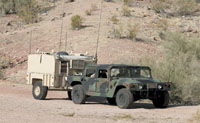 |
| The On the Move Combat Operations Center (OTM COC) is designed to provide Marine Forces with a battalion-level mobile headquarters. |
Capt. Simmons notes that the laboratory initially chose to use Iridium because it was an existing technology and infrastructure that could be quickly integrated by the service. Acknowledging that the U.S. military’s satellite communications capabilities are stretched to their limits, he notes that the ETCS provides another means of getting a message through. “Regardless of the type of satellite, it’s just another path for communications,” he says.
Although the ETCS is being field-tested, the captain does not believe that the system will ever become a program of record or be deployed in large numbers because it is intended as an interim solution before other major communications programs, such as the Joint Tactical Radio System, enter service. “You’re never going to be able to throw 1,000 handsets into a region. Right now our implementation is going to be limited to a couple of hundred handsets at best,” he shares.
However, during this period, the captain expects that the ETCS will provide widely scattered units participating in a variety of activities ranging from reconnaissance to supply convoys with an effective over-the-horizon communications system.
Another technology developed at the Warfighting Laboratory to support maneuver warfare is the OTM COC. The Marine Corps designed this application to fill a gap in its command and control capabilities, explains Project Officer 1st Lt. Andrew Dausman, USMC. He notes that the service lacks a purely mobile command post and is only now beginning to develop generic “cookie cutter” command posts for units of various sizes.
But once a commander moves from one position to another, he no longer has access to many of his communications capabilities until the command post is set up again. “We took this unit operations center idea at the battalion or aviation squadron level, and we put it in a vehicle. We made it mobile and gave it an over-the-horizon communications link so that a commander never has to lose connectivity to higher headquarters and never has to lose visibility over his subordinate units,” Lt. Dausman says.
The first prototype system was completed in June 2004. The core of the system is housed in a standard trailer and linked to two other high mobility multipurpose wheeled vehicles (HMMWVs) via a secure wireless local area network (LAN). Lt. Dausman notes that the OTM COC plugs into other pre-existing programs, allowing it to share radio networks and data services such as the C2PC that are all integrated onto a common software baseline. A Harris Company product, SECNET 11, is used to provide the 802.11b secure wireless LAN. A second development spiral will provide an over-the-horizon communications link.
Although it currently resides in a HMMWV, the OTM COC will eventually be housed in a Mercedes-Benz G-Wagon utility vehicle. This platform was selected because it can fit into a CH-53 helicopter and in the V-22 Osprey tilt-rotor aircraft for additional mobility.
A complete OTM COC headquarters consists of three vehicles and one trailer serving as a central node. Each vehicle has three operators and a driver or a battalion commander and eight staff members. A fourth vehicle will house an over-the-horizon communications capability.
Touchscreens inside the vehicles provide operators with integrated data, communications and intercom systems. The system also ties into legacy ultrahigh frequency and very high frequency radio systems. A future development spiral will provide an ad hoc networking capability. All three vehicles are linked via the wireless LAN as long as they remain within sight of the trailer. The OTM COCs will allow battalion commanders to do their job on the move without having to stop to set up equipment. “As the battalion commander is driving down the road, he is working and sending messages to his intelligence officer in the next vehicle or to the fires coordinator in another vehicle, giving him a truly mobile command post. He doesn’t have to stop doing anything while he’s moving,” Lt. Dausman explains.
The equipment in the OTM COC also features a unique cooling system borrowed from the Expeditionary Fighting Vehicle program. Called spray cool technology, it consists of servers installed in ruggedized cases. The equipment does not require any external cooling or air ventilation because all of the internal electronics are sprayed with an inert liquid that is constantly recirculated. The lieutenant explains that this combination of hard, sealed cases and an internal cooling system allows servers and other communications equipment to be submerged in water and to withstand blasts. The coolant system allows the OTM COC to avoid the operational constraints that air conditioners and generators would place on the system, he says.
Web Resources
ETCS and OTM COC: www.mcwl.quantico.usmc.mil/tech/c4.cfm
Sea Viking: www.mcwl.quantico.usmc.mil/sv/home.cfm
Spray Cool Technology: www.spraycool.com/html/technology/index.html
